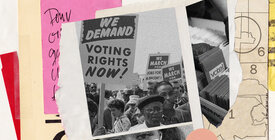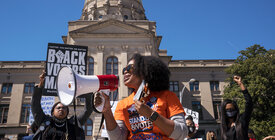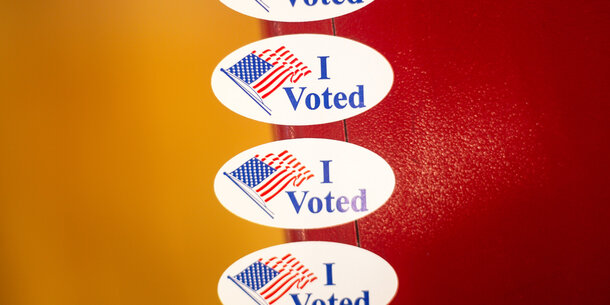Our democracy urgently needs repair.
The “Big Lie” of widespread voter fraud in the 2020 election that motivated a violent insurrection at the Capitol has sparked an unprecedented wave of voter suppression laws in the states. The upcoming redistricting cycle threatens to once again be marred by extreme partisan gerrymandering that will distort congressional elections for a decade. And our broken campaign finance system continues to foster a widespread sense from Americans across the political spectrum that their voices simply do not count relative to big donors and entrenched interests.
These challenges are, among other things, intimately connected to our nation’s history of racial injustice, from persistent efforts to keep voters of color away from the ballot box, to gerrymandering that has repeatedly sought to dilute their political power, to the racial wealth gap that is a persistent barrier to many candidates of color raising enough funds to compete.
But today we also have a historic opportunity to strengthen American democracy.
The For the People Act, passed as H.R. 1 in the House and pending as S. 1 in the Senate, would curb voter suppression and make it easier for all Americans to register to vote and cast a ballot. It would outlaw partisan gerrymandering of congressional districts. And it would overhaul our campaign finance laws to amplify the voices of ordinary Americans, combat corruption, and make federal campaign spending more transparent. Together with the John Lewis Voting Rights Advancement Act, which would restore the full protections of the landmark Voting Rights Act of 1965 hobbled by the Supreme Court, the For the People Act would move us measurably closer to realizing the promise of democracy for all.
Poll after poll has shown overwhelming public support for this legislation. One recent survey found 67 percent of Americans in favor, including 56 percent of Republicans and 68 percent of independents.
Despite the bill’s popularity, some commentators have suggested that it should be broken up because its individual pieces would be easier to pass than the whole. But the bill’s comprehensive approach is actually its greatest strength. Its ambitious scope has attracted a vast and unprecedented coalition of civil rights activists, labor organizers, faith-based organizations, environmental groups, consumer advocates, voting rights experts, and many others.
Without effective arguments against the For the People Act, some of its opponents have instead relied on misinformation. At a May 11 Senate hearing, for instance, opponents charged that it would allow Democrats to “take over our democracy,” permit “millions of people to vote illegally,” and funnel taxpayer money to politicians.
These and similar attacks are simply wrong. Here are some of the most common misconceptions about the For the People Act circulating today.
FICTION: The For the People Act is a partisan power grab
Leading opponents of the For the People Act have charged that it is a Democratic power grab, accusing the Democrats of seeking to “win elections in perpetuity” by rigging the system in their favor. This assertion is utterly baseless.
The key reforms in the For the People Act are modelled off successful practices that have been implemented in red, blue, and purple states. Forty-three states have some form of early voting and 34 states allow no excuse vote by mail, which the bill would require for all federal elections. The bill also requires states to adopt Automatic Voter Registration (AVR) — where eligible voters are registered when they provide their information to a government agency like the department of motor vehicles. AVR has been passed in 19 states of all political hues, including by a unanimous vote in the Illinois Legislature and two-thirds of voters in a Michigan ballot referendum. Redistricting reforms like those in the For the People Act have been adopted by voters in red and purple states like Colorado, Michigan, Ohio, and Utah, often by overwhelming margins. Republican states like Alaska and Montana have some of the nation’s strongest campaign finance rules.
It is simply not true that the For the People Act gives an electoral advantage to the Democratic Party. These measures benefit all Americans, regardless of party, especially over the long term. For instance, Republican voters have long taken advantage of both early voting and vote by mail at the same rate as Democrats. Redistricting reforms have helped Republicans. In California, for instance, using map-drawing criteria similar to those in the For the People Act, the nonpartisan redistricting commission drew a congressional map highly responsive to changes in voter sentiment. The result: Republicans won back four of the seven House seats they lost in the 2018 Democratic wave.
Similarly, the campaign finance reforms in the bill would have a bipartisan impact. In fact, Democrats in the last election cycle benefited more than Republicans from the sort of secret campaign spending the For the People Act eliminates. And far from a “partisan takeover” of the dysfunctional Federal Election Commission, as critics have charged, the For the People Act creates many new statutory safeguards to prevent the agency from being weaponized by either party.
The bottom line is that the For the People Act would empower the American people as whole — which helps to explain why it enjoys such widespread, bipartisan support.
FICTION: The For the People Act is a federal takeover of elections
Critics have alleged that the For the People Act would result in a “federal takeover” of elections. This is false.
Under the For the People Act, state and local governments would continue to administer all elections, just as they do now, and they would continue to set policies for their jurisdictions beyond what is required by federal law. The For the People Act merely sets baseline standards for voting access in federal contests, as Congress has done many times before.
Even though that’s not what this bill does, the Constitution gives Congress the power to completely supplant states in setting the rules for federal elections. As the late Justice Antonin Scalia wrote in a 2013 Supreme Court decision, the Constitution authorizes Congress to “provide a complete code for congressional elections” if it desires. The For the People Act stops well short of doing so; it would merely ensure that every American has a reasonable opportunity to vote no matter where they live.
FICTION: The For the People Act will allow noncitizens and people under 18 to vote
Some opponents of the bill have falsely claimed that the For the People Act would allow noncitizens or those under the age of 18 to vote in American elections. It would do no such thing.
The bill would modernize voter registration and take other steps to expand access to the ballot, but it would do nothing to weaken existing laws that prohibit noncitizens from voting. Under its automatic voter registration provisions, government agencies would only register people known to be citizens or those who affirm their citizenship, as under current law and practice. Automatic voter registration and other changes to modernize voter registration, like online and Election-Day registration, are already the law in dozens of states, and they have not led to an increase in noncitizen registration or voting.
The charge that the For the People Act would allow those under 18 to vote is equally baseless. It would allow citizens aged 16 and 17 to preregister to vote, as is currently done in more than a dozen states, but they would not be allowed to cast a ballot until they turn 18.
FICTION: The For the People Act will open the door to “voter fraud”
Another attack is that enacting the For the People Act will somehow result in widespread “voter fraud.” But there is no credible basis for this prediction.
Voter fraud is vanishingly rare, and efforts to show otherwise have been soundly debunked. Key reforms in the For the People Act, like modernizing voter registration and expanding access to early voting and vote by mail, would do nothing to change this basic reality. Already, tens of millions of Americans vote in states with similar rules, and there is no evidence of any uptick in fraud.
If anything, such changes often make our elections more secure. Automatic voter registration, for example, has been shown to increase the accuracy of the voter rolls. The For the People Act also includes other much needed election security provisions, like requiring the use of voter-verified paper ballots and offering more funding for post-election audits to confirm results.
Critics of the For the People Act have often zeroed in on its provisions expanding access to mail voting, repeating false allegations of widespread fraud in the 2020 vote, in which unprecedented numbers voted by mail and many burdensome requirements (like witness signature and ballot notarization) were relaxed due to the pandemic. False allegations of fraud in 2020 are the same lies that fueled the January 6 insurrection.
In reality, the evidence shows there is no widespread fraud in connection with mail voting. States have been voting by mail for decades. Oregon, a pioneer in this area, has sent out approximately 100 million mail ballots since 2000 and has documented only about a dozen reported cases of fraud — that is 0.0001 percent of all votes cast. An exhaustive analysis by investigative journalists of all known vote fraud cases between 2000 and 2012 found exactly 491 cases of mail voter fraud.
As one noted scholar pointed out, “literally billions of votes” were cast during that period. As with in-person voting, it is more likely for an American to be struck by lightning than commit mail voter fraud. Likewise, hundreds of officials — including scores of Republicans ranging from high-level appointees at the Departments of Justice and Homeland Security, to state and local election officials, to multiple federal judges nominated by Republican presidents — have confirmed that there was no widespread fraud in 2020.
In making mail voting more accessible, the For the People Act would not increase the risk of fraud. However, it would help to ensure that all eligible Americans, including voters who are disabled or live in rural areas without reliable access to transportation, have the opportunity to easily and securely cast a ballot.
FICTION: The For the People Act will funnel taxpayer money to politicians and foment political extremism
Opponents of the For the People Act have claimed that the bill’s campaign finance reforms will divert taxpayer money to politicians and encourage political extremism. These assertions are mistaken.
The For the People Act would create a voluntary small donor matching system for federal elections, under which small contributions to participating candidates would be matched at a six-to-one ratio. Small donor matching, which has been used in presidential primaries and at the state and local level for decades, gives candidates a way to fundraise without relying primarily on donations from the very wealthiest contributors and special interests.
It is the best antidote to the inequities of the current system, in which $1 out of every $13 contributed over the last six election cycles has come from just a dozen megadonors and their spouses. Small donor matching benefits the vast majority of candidates, but it is especially useful for candidates of color, particularly women, who thanks to historic discrimination often cannot access the same wealthy networks as their white counterparts.
This program does not use any taxpayer money. It is entirely funded by a surcharge to be assessed primarily on penalties from corporate lawbreakers. The bill expressly forbids any use of taxpayer funds.
A few academic commentators have worried that empowering small donors will result in more elected officials with ideologically extreme views. But overall, small donors are no more ideologically extreme than the large donors who currently bankroll our campaigns. Small donors do support some ideologically extreme candidates (so do large donors), but many moderate and establishment politicians are also highly successful small dollar fundraisers.
Moreover, public financing programs that reward small donor fundraising tend to broaden the range of people who give to campaigns, including incentivizing more of a candidate’s own constituents to give. In other words, such systems tend to make the pool of donors look more like the electorate overall rather than empowering ideological extreme segments.










